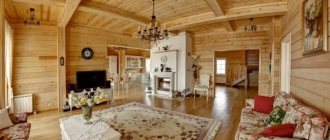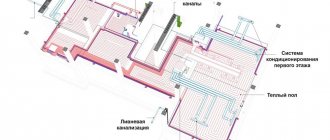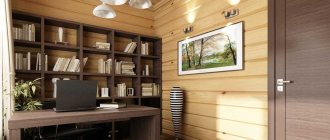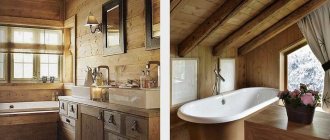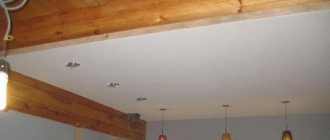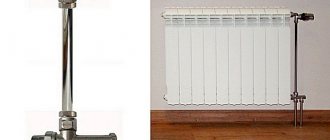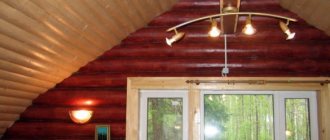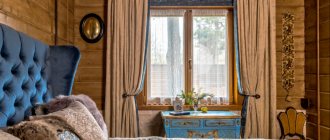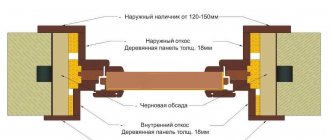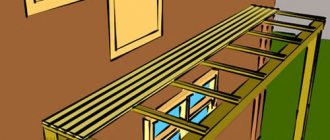Wood is considered an environmentally friendly material for the construction of residential buildings, so it is not surprising that the demand for beautiful and comfortable houses made of timber or rounded logs is not decreasing. First of all, a residential building must be safe from an electrical installation point of view.
It is important to understand how electrical wiring should be done in a wooden house. You need to know how to install and organize the electrical system so as not to harm the health of residents and ensure the safety of property. We have presented in detail all aspects of this issue.
Our article will introduce you to the general requirements for wiring. We will talk about methods for installing an electrical network in a house, rules for arranging an electrical panel and methods for installing cables. All electrical installation work must be carried out in strict accordance with the fire safety regulations we provide.
General wiring requirements
The main difference between wooden houses and reinforced concrete and brick structures is their high degree of fire hazard. This means that increased requirements apply to the selection of electrical devices, cables and the conditions for their installation.
According to statistics, about 1/2 of fires or ignitions in wooden houses or in houses with wooden trim occur due to gross errors by electricians.
If you install the socket incorrectly, do not connect the wires in the junction box carefully enough, or ignore the grounding rules, a fire may occur, followed by a fire.
Undemanding owners of a wooden house entrust electrical installation work to neighbors, acquaintances, or do it themselves, without thoroughly knowing the PUE standards. The sad result of gullibility and unprofessionalism - in the photo
It is necessary to know the basic rules of electrical installation for two reasons: to be able to carry out some of the installation or repair work yourself and to control the actions of unscrupulous “specialists”.
The following requirements should be remembered:
- The technical characteristics of cables and electrical equipment must correspond as closely as possible to the power consumption of the devices of each individual group.
- The operation of sockets, switches, and emergency shutdown devices must be carried out taking into account the load placed on them.
- It is prohibited to use cables, wires, and terminal connections when they are regularly heated.
- It is necessary to completely prevent the transfer of fire from the cable to structures made of wood or other flammable materials using fireproof protection.
Electrical wiring must be completely safe for home owners, their families (especially small children) and pets.
Strict requirements come to the fore, and sometimes aesthetics have to be sacrificed. For example, owners of a wooden cottage need to come to terms with external sockets and enhanced protection for both hidden and open electrical wiring (NPB 246-97)
Material from video reviews and instructions posted on the Internet is very contradictory, so you should not rely entirely on the opinion of people in work overalls. You should focus on excerpts from regulatory documentation - sections of PUE, SNiPs, GOSTs.
Electrical wiring in a wooden house. Installation rules
Light, heat, the operation of engineering and household equipment - everything is based on electricity. Therefore, the level of comfort depends entirely on the uninterrupted and, importantly, safe operation of the electrical network. Any defect or mistake made during the installation of electrical equipment and electrical wiring can lead to dire consequences - fires or fires.
The topic of proper installation of electrical wiring for wooden houses is especially relevant, because... due to discrepancies in the interpretation of the PUE (Rules for the Construction of Electrical Installations) and the SP (Code of Rules), confusion and a lot of controversy arises. Therefore, in this article we will answer the following questions:
- What are the basic principles of installing electrical wiring in a wooden house?
- How electrical wiring is installed in a wooden house in accordance with the rules of the PUE and SP.
- Technical features of installation of hidden electrical wiring.
Correct electrical wiring in a wooden house
Wood is a general construction material with a long history. Both small guest houses and large-area cottages are built from it. Despite all the advantages of both log and frame houses, the basis of which are wooden posts, many believe that such buildings have an increased fire hazard. But one important point is missed.
Regardless of what the house is built from - brick, aerated concrete, timber or rounded logs, upholstered furniture, curtains, curtains, interior items, household appliances, etc. burn first. Those. - the “filling” of the house, made of combustible materials.
In a stone house, the electrical wiring running from the distribution board to the consumers is mounted in fireproof material (the cable is laid in grooves, which are then sealed and plastered, etc.).
In the case under consideration, the developer faces a difficult choice - the wiring in a wooden house can be external , the cable can be routed inside wooden walls or between frame posts.
How to lay cable in a wooden house.
Let's consider all these methods of laying wires in a wooden house. If in the first case the electrical wiring is visible, which affects the speed of detection of an emergency situation (cable overheating, etc.), then in the second option it is hidden behind the cladding or in solid wood. Accordingly, what happens to the cable is unclear. Hence the fears and doubts of the developer: “What if something happens to the electrical wiring? Will it light up or not?
Practice shows that the “weak” point in the electrical network is not the cable itself (we do not consider cases of gross violation of installation, the use of a cable with a reduced cross-section, on which a large load was “hung”, “twists” on electrical tape on the route to splice the cable), but connection points - junction boxes, terminals for connecting consumers, i.e. sockets, switches, etc.
Modern power cables, with the abbreviation VVGng, etc., do not support combustion.
There are constant debates about where it is safer to run the cable - outside or inside the walls, and whether open wiring is acceptable in a wooden house. There is an opinion that if we lay wiring along the wall, this will give us time to see and react to an emergency situation and make the right decision on how to proceed. Put out the fire or evacuate.
Simply put, smell the smoke immediately, and not later, when the flame has already spread to the structural elements. If the electrical wiring is mounted in the wall, even in a steel pipe, then this may also not save you from a fire.
SemikFORUMHOUSE user
I can refer to my experience as a firefighter and my experience as an electrician in emergency situations. Steel pipes are more needed for mechanical protection of wiring from the “fool”, the teeth of rats, which can gnaw even through a metal hose and damage the cable. I have seen more than once how a steel pipe, with wiring shorted inside, became red-hot. If this happens in a wooden wall, a fire is inevitable.
According to the user, the first thing you should think about when installing electrical wiring is the correct calculation of all cable sections and the selection of electrical equipment for protection. That is, figuratively speaking, there is no point in installing a 100 A circuit breaker on a wire with a cross-section of 0.75 square meters. mm with a distance to the consumer of one kilometer.
Hence, a safe electrical network is a balanced system where each element, from circuit breakers to the cross-section and length of the cable, as well as the end consumer, is matched to each other. It is a delusion to hope that by stretching a cable through a metal pipe in a conventional wooden wall, we have already protected ourselves from fire. The rules for laying cables in a wooden house are a rather vague thing, so far we have solved only part of the complex problem, which will be discussed below.
PUE and SP: standards and rules for installing electrical wiring in wooden and frame houses
Let us repeat once again that we have left outside the scope of this article the external installation of electrical wiring in cable ducts. We also do not consider the so-called retro wiring. This option, both in terms of design and financial component, is not suitable for everyone.
Therefore, we set the task - it is necessary to install hidden electrical wiring in a wooden or frame house in a safe and regulated way.
Which wire to use for a wooden house
It seems that everything is simple - you need to open the PUE (seventh edition dated 07/08/2002) and read paragraph 7.1.38, which says:
Electrical networks laid behind non-passable suspended ceilings and in partitions are considered as hidden electrical wiring, and they should be carried out: behind ceilings and in the voids of partitions made of flammable materials in metal pipes with localization ability , and in closed boxes; behind ceilings and in partitions made of non-combustible materials - pipes and ducts made of non-flammable materials, as well as flame retardant cables. It must be possible to replace wires and cables.
Now we open the document for frame builders, namely SP 31-105-2002 “Design and construction of energy-efficient single-apartment residential buildings with a wooden frame.” Read paragraph 13.5.1:
Electrical wiring should be installed by passing cables (wires in a protective sheath) through voids or spaces filled with insulation inside the walls and ceilings of the house, as well as through holes in the wooden frame elements of walls and ceilings . The passage of such cables and wires through the structure of the house can be arranged without the use of bushings and tubes .
And paragraph 13.5.2:
For electrical wiring, insulated wires in protective sheaths or cables in sheaths made of flame retardant materials .
- A cable is two or more insulated conductors connected together and covered with insulation.
- A wire is a single-core or multi-core conductor with or without insulation.
Cable for wiring in a wooden house.
Accordingly: due to discrepancies in the PUE with the joint venture and the vagueness of the wording in the PUE, many users have a question - how to properly install electrical wiring on flammable materials. As prescribed in the PUE - by laying it in a steel pipe. Or as it is written in the joint venture - using a flame retardant cable without additional protective sheaths. Many disputes arise on this basis.
Vitalik1985FORUMHOUSE user
I think that laying cables in steel pipes is an overkill solution. The likelihood that a cable will break is negligible; fires most often occur due to a spark in an outlet. It is better to pay more attention to circuit breakers, connections, junction boxes, switches, etc.
Danil117FORUMHOUSE user
It is necessary to do so to eliminate the possibility of the wire catching fire. We choose the correct cable cross-section and select high-quality machines. That is, we do not hope that a steel pipe is a panacea for fires and fires.
We will also consider opposing opinions.
SollaraFORUMHOUSE user
I believe that the wires for a wooden house should be in a metal pipe that has localization capabilities. If the wire catches fire, it will burn out inside. If it is shorted, the arc will not burn through the pipe. We install metal junction boxes connected to the pipe.
A steel pipe for electrical wiring in a wooden house must be grounded.
Also interesting is the opinion of a portal user with the nickname Kostya Ivanov.
Kostya IvanovForumHouse Member
By laying a cable in a metal pipe, we solve two problems: we protect the cable from possible mechanical damage and protect the tree from possible fire of the cable.
Moreover, the first point acquires key importance in relation to our construction conditions. Workers can, while installing drywall or drilling something, pierce an unprotected cable with a screw or nail. The cable insulation can be damaged by the sharp edge of the metal profile. The cable can be chewed (optionally) by rats or mice. In addition, the accumulation of wood dust during a spark or breakdown of insulation can lead to the rapid spread of flames inside the walls.
It seems that such a solution is redundant, but in this way we protect the cable from force majeure circumstances, including the common situation: “I forgot where the cable goes in the wall, hung a shelf/picture and damaged it.”
Although, in order to avoid such situations, we do not lay the cable as it is necessary, but along strictly defined and marked cable routes, if necessary, taking photographs with an attached tape measure.
Is corrugation acceptable for electrical wiring in a wooden house?
From all of the above, it becomes clear that some FORUMHOUSE users believe that the electrical cable in wooden houses, with hidden wiring, should be routed only in metal pipes. We emphasize that it is in steel pipes , and not in a metal hose, plastic self-extinguishing corrugation or steel corrugated pipe.
Corrugation for wires in a wooden house with hidden wiring is not suitable!
A short circuit (short circuit) arc burns through a steel corrugated pipe, and plastic corrugation, due to its fragility, will not save the wiring from mechanical damage.
Others believe that a metal pipe for electrical wiring in a wooden house is redundant and rely on foreign experience, which allows for a cable in a log. In a classic frame using North American technology, the electrical cable is pulled directly through wooden posts, in drilled technological holes, without corrugations, metal pipes, etc.
In the “Finnish” version of the frame, the electrical cable is usually pulled in the inner layer of counter-insulation, embedded in a wooden counter-lattice.
It seems that the technology can be repeated, because it has stood the test of time, but, as we know, the essence is in the details.
“Overseas” it is necessary to make a grounding, and a double one - one goes to the street line, to the switchboard, the second is independent, connected either to copper pins driven into the ground, or to a central water pipe. Plus, there is also a “zero” bus, and each line and electrical appliance (sockets, lamps, etc.) has its own independent grounding.
RoracottaFORUMHOUSE Member
There are 4 thick cables running underground to the meter in the house. Ground, zero and two phases. In addition to this ground on the cable, the central panel and meter itself must be grounded with a separate ground or to a copper pipe when entering the house, or with two 16 mm copper pins 2 meters long, or with a special copper plate buried in the ground to a depth of about a meter.
In a three-core “foreign” cable, the copper wire is “ground” and comes without braid. This ensures that the RCD is triggered at the slightest damage to the insulation of the “zero” and “phase” wires along the entire route. While in our country the grounding wire is isolated and provides protection only to end consumers.
Roracotta
In Canada, a rule was introduced - all lines that supply bedrooms must be equipped with special circuit breakers that are sensitive to sparks jumping at the consumer (plug, socket, etc.). If a spark jumps somewhere, the machine knocks out. It's expensive, but it needs to be done.
And this is only part of the nuances that ensure electrical safety. Having decided to run a cable in a steel pipe in houses built from timber, we remember that wood shrinks over time. Moreover, depending on the moisture content of the source material, this value can be significant. This means that we need to think in advance about how to ensure the necessary movement/independence of the steel pipe with the cable, so that the beam does not “hang” on it after 2-3 years.
Condensation may form in the steel pipe, and moisture may enter the outlet or junction box due to the slope of the route. Another “headache” is how to build tracks in large wooden houses. It’s one thing to lay steel pipes in a wooden cottage of 100-150 square meters. m, but the task is completely different in complexity - in houses of 300-500 sq. m. In addition to increasing the estimate, special requirements are also placed on the qualifications of workers involved in the installation of electrical wiring in steel pipes.
Therefore, examples of the practical implementation of cable wiring in metal pipes are interesting.
Kostya IvanovForumHouse Member
I installed the electrical wiring in the wooden ceiling of the attic floor, in a steel square pipe 15x15 mm, with a VVGng cable with a section of 3x2.5. Turns and bends - a metal hose with a diameter of 20 mm, it fits well onto the pipe.
A square pipe is more convenient to install than a round one.
Installation of wiring in a log house
Also interesting is the electrical installation in a wooden house , done by a user with the nickname Serg177. To do this, he bought a 15x15 mm pipe 300 meters long and a metal corrugation with a diameter of 2 cm, as well as brackets (they are used to fasten corrugations with a diameter of 1.5 cm) for fixing the pipes on the walls. Next, we install the wiring, not forgetting to first clean the edges of the pipes from burrs !
If this is not done, you can cut through the cable insulation.
What happened in the end and how the wire passes through the beam is shown in photographs.
Which cable is better for a wooden house
The following photo report was provided by MrPie. This is already a frame house.
MrPieFORUMHOUSE Member
I took the cable VVGng-FRLS (fire-resistant). I put it in a metal corrugation. I passed everything through combustible structures in a water pipe. Next, before finishing, where the cables pass, I will attach a metal profile and cover it with plasterboard.
In addition, the cross-section of the wires was calculated and protective equipment was selected. The lines were conducted without twists/connections and junction boxes, with solid cables from the switchboard with the machine to the consumer.
Summarizing
The use of one or another method of laying wires should be based on the principle of sufficiency and common sense, without excessively complicating the system where this can be avoided. Wiring on wooden walls should be installed according to the following instructions:
- The cross-section of wires and parameters of protective equipment must correspond to the power of the end user.
- We buy a cable from a well-known and well-established company; we risk buying a cable with a reduced cross-section.
- We use high-quality circuit breakers. Saving on protective automation can backfire - it may simply not work at the right time.
- No “twists” wrapped in electrical tape, no maintenance-free home-made connections “walled up” in the wall. If possible: we minimize the number of junction boxes, we try to run one whole wire from the circuit breaker to the end consumer.
You can find all the necessary information on electrics in the FORUMHOUSE section “Electrical equipment, electrical installation”. We also recommend studying the topic: options for laying cables on various building structures and how to install hidden electrical wiring in a wooden and frame house.
From the article you can learn how to install electrics in a bathhouse, and this material tells you how to introduce electricity into a house.
In addition, our portal has detailed instructions for connecting electricity to the site and country house.
And the video shows how to install electrical wiring in an apartment.
Features of the electrical panel
Externally, the distribution board is a plastic or metal (which is preferable) box with a door with fastenings for automatic machines and an electricity meter.
It has no size restrictions, and when a new box is installed, a little free space is always left for further connections.
Inside there is a meter (sealed), a main automatic shutdown device (RCD), which is also sealed, and single-pole circuit breakers for various groups of electrical wiring (lighting, socket, etc.)
Circuit breakers are mounted on the DIN rails provided for this purpose. The nominal value of the machines directly depends on the parameters of the connected line: if the permissible limit of the socket group is 16 A, then the machine must correspond to this value.
If you have automatic machines, installing an RCD is not necessary, but its installation should not be neglected. Additional protection is triggered when a leakage current appears. The RCD is manually turned off when it is necessary to cut off the flow of electricity into the house.
Despite the expensive cost of the equipment, responsible electricians insist on installing zone-based protection, which increases the safe use of the electrical network in a wooden house.
The nuances of connecting RCDs and circuit breakers in the panel are described in this article.
Stages of hidden wiring installation
It should be noted once again that the installation of a hidden power supply network in a wooden house should be carried out in special metal cable ducts, distribution and installation boxes. The technology of such hidden wiring is divided into the following stages.
- The route is being prepared for the placement of cable ducts, distribution and installation boxes. Using a tool, grooves, mounting locations for network elements and interroom transitions are cut or drilled into wood. For frame houses, the process immediately begins with the installation of cable channels in the unfilled voids of the structure.
- Cable channels (pipes or ducts) are prepared for installation. They are cut into the required pieces according to the installation diagram, cleaned and, if necessary, threaded. Interior sleeves and other network elements are also prepared: distribution boxes are equipped with terminal strips, and all other components are cleaned of contaminants.
- Distribution and mounting boxes, interroom transition sleeves, pipes or cable ducts are installed, joined and secured in grooves or other voids in the structure. The pipes are secured with clamps matched to the size of the cable ducts, or with special metal plates recessed into the wood.
- The most critical stage of installation is pulling cables and wires into cable channels and connecting them. After pulling, it is necessary to check the integrity of the cores and insulation using a tester; only after this can you connect the wiring to the network elements, using the color of the core insulation as a guide.
After all work has been completed, it is necessary to check its quality. A simple test using a tester or a probe light is not the most suitable option. It is better to invite a specialist with the appropriate equipment, who is authorized to issue an official document for verifying the electrical wiring. This certificate will allow you not only to safely use the electrical network, but also to avoid problems with regulatory authorities. You should not save on this procedure, since the cost of household appliances that may fail due to a short circuit far exceeds the cost of such a check! At the last stage, the entire hidden wiring structure is covered with decorative or other elements.
Fire protection measures
If we analyze the entire process of electrical installation work in a wooden house from a safety point of view, we can highlight the main rules:
- correct selection and installation of RCD;
- installation of a grounding loop using a modular-pin method (with a resistance of 4 Ohms);
- installation of a potential equalization system;
- ensuring grounding continuity throughout the entire network;
- installation of overhead sockets only;
- hidden installation - in metal boxes and pipes.
Upon completion of electrical installation work, the risk of accidental fire or electric shock, as well as breakdown of household appliances due to unsatisfactory wiring conditions, must be completely eliminated.
Selection of materials
It is strictly not recommended to save on the purchase of tools, cables and other materials. It is better to buy high-quality, certified products from trusted manufacturers, which will significantly increase the durability of the system and the safety of network users.
Electricity must be supplied to the house using a thick cable with aluminum conductors; the wiring inside the building is made of copper products. Preference should be given to three-wire wires in order to ground powerful electrical appliances without any problems in the future. When connecting lines, copper or brass bars are used.
General recommendations
When installing networks, it is necessary to take into account the location of water pipes, heating and gas supply lines. The distance from water routes to cables should not be less than 100 mm, and from gas routes - from 400 mm.
At the transition points between floors or walls, it is necessary to drill a hole and install a sleeve made from a piece of water pipe.
To protect against condensation, a seal is used that can be removed without the use of special tools.
When choosing a cable, it is recommended to use a 3-core cord with a cross-section of 2.5 mm² for sockets, and for lighting devices with incandescent lamps, a wire with a cross-section of 1.5 mm² is sufficient (when using LEDs, the parameter can be reduced to 1 mm²). If the house has equipment with high energy consumption (more than 2.5 kW), then separate circuits should be provided from a copper 3-core cable with a cross-section of 6 mm². The reliability of the power supply system in a wooden or frame house depends on the correct selection of wire cross-section.
Do-it-yourself installation of a distribution board
The electrical panel housing is fixed in the place specified by the diagram. After this do the following:
- the metering device is mounted in the panel housing;
- An input machine is installed on a special metal profile (din rail). A phase and a neutral are supplied to a two-pole circuit breaker;
- the output clamps (terminals) of the metering device are connected to the input of the input circuit breaker;
Stripping the wires should only be done when the power is turned off.
- the wire is brought into the house and connected to the input terminals of the metering device (meter);
- Voltage relays, circuit breakers for different power groups (sockets, lighting fixtures), and RCDs are mounted on a DIN rail;
- The terminals of electrical appliances are connected with a single-core cable.
Useful tips
- When carrying out electrical wiring in multi-storey buildings, a more powerful cable is used, which differs from a private building. Therefore, before carrying out work, it is necessary to calculate the entire electrical load and purchase the necessary wiring.
- For log houses, the most suitable cable is considered to have triple insulation, which has a non-flammable base, this allows you to protect the room from fire.
- The most reliable devices for protecting the main system from emergency situations are considered to be automatic devices. They are capable of connecting two protection devices, that is, an automatic type switch and a residual current device.
- You must remember to make grounding for each distribution box and pipe. This is a mandatory action if the work is done correctly.
- The pipes must be connected securely so that a possible spark does not penetrate through the holes; for this, all seams are welded or soldered.
- When purchasing materials, you need to take into account that copper pipes bend better and form the required shape, making them easier to work with.
- To protect the cable while threading it into the pipe, end-type bushings are used, which are made of plastic material.
- Also, when conducting wiring, possible shrinkage of the structure is taken into account, this helps prevent pinching of electrical wires.
- If the inside surface of the walls is covered with clapboard or wallpaper made of wooden material, then the recesses do not need to be drilled, and the pipes and cables are routed through the grooves made in advance. This saves time when working with electricity.
- In some cases, hidden wiring is combined with an open type; this is done in areas where the cable is supplied to a socket or switch.
The main condition for conducting electricity in a log house is to hide the cable in metal pipes. Wooden material has a high risk of fire, and if the basic condition is not met, an accidental spark may occur in the wiring, which will lead to disastrous consequences. Each section of pipe or metal tray is grounded, and distribution boxes with emergency switches are installed in several sections. If the work is done correctly, hidden wiring will serve for many years, and the interior of the room will retain its appearance. If you have doubts about doing the work yourself, it is better to contact specialists.
Our prices
| Works | Unit change | Prices | |
| Area up to 70 sq. m 22 electrical points; box for 12-18 modules | from 38,000 rub. up to 60,000 rub. | ||
| Area up to 110 sq. m 45 electrical points; box for 24 modules | from 38,000 rub. up to 60,000 rub. | ||
| Area up to 150 sq. m 60 electrical points; box for 36-48 modules | from 90,000 rub. up to 125,000 rub. | ||
| Installation of a turnkey ground loop | PC. | from 15,000 rub. | |
| Digging a trench 400×700 mm With installation of an armored cable in a HDPE pipe, backfilling with 150 mm sand, laying warning tape, backfilling | linear m | 1000 rub. | |
View full price list
Drawing up an estimate for electrical installation work - FREE!
Preparatory work
Design is the first stage of building electrification. You should decide where the sockets, switches, distribution boxes will be located, how the cable lines will run, and so on.
Installation tools
A man who considers himself a master must have all the tools necessary to install electrical wiring. If they are not there, then you are unlikely to install cables in the house yourself.
Let's list the main tools:
- drill and/or screwdriver;
- wire cutters;
- Screwdriver Set;
- screwdriver with indicator;
- stationery knife;
- tape measure and pencil;
- level;
- ladder or other devices to reach high points.
Tools for electrical work
Pliers, a saw and a hammer may also come in handy.
Consumables
In addition to the electrical cable, to supply electricity to the house and lay communications inside the building you will need:
- protective devices: corrugations, metal hoses or pipes;
- distribution boxes;
- socket boxes;
- mounting boxes;
- sockets and switches;
- clips or other fasteners to secure the protective devices and cable inside;
- clamps for fastening the input cable;
- self-tapping screws;
- electrical insulating tape.
Wiring materials
Drafting
Next, you need to draw up an electrical wiring diagram, which displays all electrical points (switches, sockets and lamps, heaters), distribution boxes, panels and the cable line itself. Switches should be installed near the doors, sockets should be installed closer to the places where electrical appliances will be located. Otherwise you will have to use extension cords.
When drawing up a diagram, you need to take into account all the objects located in the room: doors, windows, pipes and heaters.
Calculate the total load of appliances used in each room. In accordance with the obtained value, select the correct cable cross-section, which should be 15–20% larger than the recommended one. The total load in the house will allow you to decide on the differential circuit breakers used.
Layout of electrical wiring in the house
After drawing up the diagram, mark the interior using a building level, a pencil (marker), a tape measure and a ladder. Display “crosses” at the locations of the electrical points. The distance between the floor and the socket must be at least 300 mm, between the floor and the switch - 900 mm.
Rating and type of machine for single-phase power supply
The circuit breaker is selected based on the following:
- determine the sum of the power of all electrical equipment and calculate the value of the maximum current using the formula: Ihom = P / U x cosϕ. The cosϕ value is taken to be 0.8. A correction factor of 1.1 is applied to the resulting value of rated current Ihom. As a result, the maximum current value at which the machine is triggered is obtained. A 25 A circuit breaker is usually quite sufficient for entering a house;
- To determine the type of machine, you should know the minimum value of the short circuit current. The formula for determining the current in a single-phase network (220 V) is as follows: Is = 3260 x S / L, where S is the cable cross-section, (mm²); L—cable length, (m). This formula determines the current for the longest section with the smallest wire cross-section;
The input circuit breaker must maintain the power supply to the house at maximum load.
- The ratio of the short circuit current to the rated current determines the characteristics of the circuit breaker. The recommended circuit breaker for installation in the house is a switch with characteristic C. Such a circuit breaker works perfectly in networks with a mixed load.
According to the electrical wiring diagram, in a private house, they install an introductory machine after the meter with their own hands. Automatic switches for devices combined into one group, a metering device, an input circuit breaker and an RCD are mounted in an electrical panel on a special metal profile (DIN rail). Next, the wiring is carried out according to the wiring diagram for installing electrical wiring in a private house.
RCD connection diagram.
Basic rules for conducting internal electricity
Electrical wiring is done so that there are as few bends and turns as possible; for this, a diagram is first drawn up. In this case, electrical wiring must be laid only in non-combustible materials.
While performing work, in some cases it is necessary to disrupt the aesthetic appearance of the room while maintaining fire safety. Recesses for the cable are made in the openings of doors, windows, under the baseboard or overhead elements of the ceiling.
If corrugated pipes are used, they must be protected with asbestos gaskets. Pipes for insulation and boxes are connected by welding or screwed together.
For an aluminum wire core, 2.8 millimeters in 10mm2, and for copper material, 4mm2. In this case, the cable should occupy no more than 40 percent of the volume inside the pipe. Before the cable is pulled through the pipe, and after that, the resistance is measured with a special device. Distribution boxes are placed so that they can be accessed. When wiring a hidden type, purchase cables with a triple-type insulating coating; they are marked “ng”.
